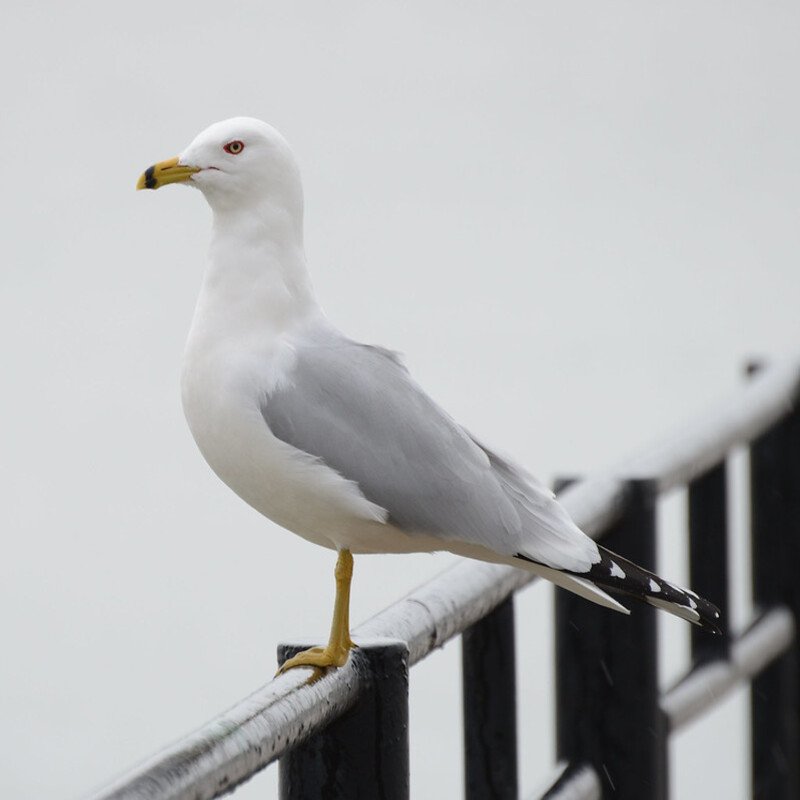Ring-billed gulls, Larus delawarensis are medium-sized gulls. The genus name is derived from the Latin word larus, which appears to allude to a gull or other huge seabird. The name delawarensis relates to the Delaware River.
Quick Overview: Larus Delawarensis – Ring-Billed Gulls
Body size: Around 18-19 in (46-48 cm) and a weight of 590 g (20.81 oz)
Main colors: Blue-Gray, White, Yellow, Black, Green
Range: Throughout the United States
Migratory Bird: Yes
Best time of the year to see in the U.S.: January, February, December
Conservation Status: Least Concern
Ring-billed Gulls Description
Ring-billed gulls have a pale bluish-gray back and shoulders, and a white head. The wings have black tips with visible white dots, and the abdomen is pale. The legs and feet of ring-billed gulls are yellowish or greenish.

Size
These birds have a length of 18-19 in (46-48 cm) and a weight of 590 g (20.81 oz). Their wings could range from 47-48 in (119-122 cm).
Feeding
Ring-billed gulls are opportunistic feeders, or scavengers, which means they will eat nearly anything. They consume fish, rodents, tiny aquatic animals, bird chicks and eggs, insects, and vegetable materials such as fruits, but prefer animal meals.
Habitat
These birds spend a lot of time on inland rivers. They can be found in locations with a sandy terrain and little vegetation. They can also be found in areas with rocks and concrete pieces, on pebble beaches, and occasionally in wet meadows.
Behavior
Ring-billed gulls are migratory and diurnal birds. They are also quite sociable, living in big colonies, particularly during the breeding season. Within nesting colonies, they defend tiny territory. They play by dropping objects while in the air and then swooping down to retrieve them. They may grab food from other gulls and European starlings while also defending themselves against other birds that may steal their food.
Larus Delawarensis Scientific Classification
- Kingdom: Animalia
- Phylum: Chordata
- Subphylum: Chelicerata
- Class: Aves
- Order: Charadriiformes
- Family: Laridae
- Genus: Larus
- Species: Larus delawarensis
Best time of the year to see
The best time to see these birds in the United States is during the winter season (December to February).
Distribution of the Ring-billed Gulls in the USA
Breeds in California, the northern Great Plains and southern prairie provinces of Canada, the Great Lakes region, the Canadian Maritimes, and northern New England. Winters on the beaches, rivers, and lakes from southern New England to Cuba, the Great Lakes to the Gulf Coast, and British Columbia to southern Mexico.
The Ring-billed Gulls can be found in the following states in the United States – Alabama, Alaska, Arizona, Arkansas, Colorado, Connecticut, Delaware, Florida, Georgia, Hawaii, Idaho, Illinois, Indiana, Iowa, Kansas, Kentucky, Louisiana, Maine, Maryland, Massachusetts, Michigan, Minnesota, Mississippi, Missouri, Montana, Nebraska, Nevada, New Hampshire, New Jersey, New Mexico, New York, North Carolina, North Dakota, Ohio, Oklahoma, Oregon, Pennsylvania, Rhode Island, South Carolina, South Dakota, Tennessee, Texas, Utah, Vermont, Virginia, Washington, West Virginia, Wisconsin, and Wyoming.
